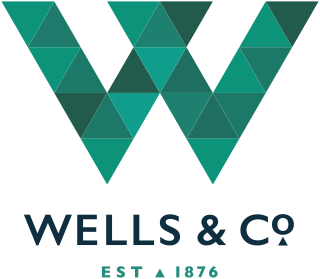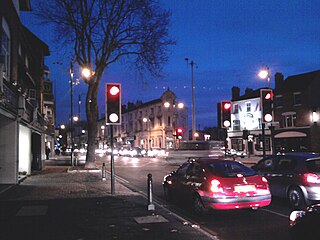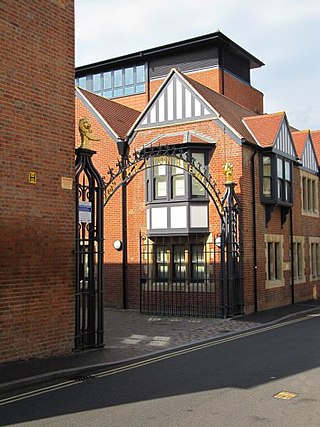
Oxford is a city and non-metropolitan district in Oxfordshire, England, of which it is the county town. Founded in the 8th century, it was granted city status in 1542. The city is located at the confluence of the rivers Thames and Cherwell. It had a population of 162,100 at the 2021 census. It is 56 miles (90 km) north-west of London, 64 miles (103 km) south-east of Birmingham and 61 miles (98 km) north-east of Bristol. The city is home to the University of Oxford, the oldest university in the English-speaking world; it has buildings in every style of English architecture since late Anglo-Saxon. Oxford's industries include motor manufacturing, education, publishing, information technology and science.

A pub is a drinking establishment licensed to serve alcoholic drinks for consumption on the premises. The term first appeared in the late 17th century, to differentiate private houses from those open to the public as alehouses, taverns and inns. Today, there is no strict definition, but CAMRA states a pub has four characteristics:
- is open to the public without membership or residency
- serves draught beer or cider without requiring food be consumed
- has at least one indoor area not laid out for meals
- allows drinks to be bought at a bar

Ringwood Brewery is a brand of beer owned by Carlsberg Marston's Brewing Company, and was formerly a small brewery on the edge of the New Forest in Hampshire, England, near the Dorset border. It produced mainly cask ales and some bottled beers.

Fulham is an area of the London Borough of Hammersmith & Fulham in West London, England, 3.6 miles (5.8 km) southwest of Charing Cross. It lies on the north bank of the River Thames, bordering Hammersmith, Kensington and Chelsea. The area faces Wandsworth, Putney, Barn Elms and the London Wetland Centre in Barnes. on the far side of the river.

The Oxford Canal is a 78-mile (126 km) narrowboat canal in southern central England linking the City of Oxford with the Coventry Canal at Hawkesbury via Banbury and Rugby. Completed in 1790, it connects to the River Thames at Oxford, and links with the Grand Union Canal, which it is combined with for 5 miles (8 km) between to the villages of Braunston and Napton-on-the-Hill.

Marston's plc is a British pub and hotel operator. Founded by John Marston in 1834, it is listed on the London Stock Exchange. Marston's disposed of its brewing operations in 2020, selling the assets to a newly formed joint venture with the Carlsberg Group to create the Carlsberg Marston's Brewing Company (CMBC), in which Marston's plc holds a 40% share.

A pub chain is a group of pubs or bars operating under a unified brand image. Pubs within a chain are tied houses and can, generally, only sell products which the chain owner sanctions. Pubs in a chain normally display their chain branding prominently and may also feature shared aspects, such as menus and staff uniforms.

Brains is a regional brewery based in Cardiff, Wales. It was founded in 1882 by Samuel Arthur Brain. At its peak, the company controlled more than 250 pubs in South Wales, Mid Wales and the West Country but the brewer sold most of its pub estate in 2022. The company took over Crown Buckley Brewery in Llanelli in 1997 and Hancock's Brewery in 1999. In 2000, Brains moved to the former Hancock's Brewery just south of Cardiff Central railway station. The Old Brewery, in Cardiff city centre, has been developed into a modern bar and restaurant complex.

The Wenlock Arms is a public house in Hoxton, in London's East End, which began trading in 1787. The pub is located halfway between Old Street and Angel, just off the City Road and the City Road Basin and Wenlock Basin on the Regent's Canal. The pub has won awards for the quality and range of its cask ales.

Theale is a village and civil parish in West Berkshire, England. It is 5 miles (8 km) southwest of Reading and 10 miles (16 km) east of Thatcham. The compact parish is bounded to the south and south-east by the Kennet & Avon Canal, to the north by a golf course, to the east by the M4 motorway and to the west by the A340 road.

W. H. Brakspear & Sons Ltd. is a brewer in Henley-on-Thames, Oxfordshire. Since the closure of its original brewery in Henley-on-Thames in 2002, most of its beers have been brewed by Wychwood Brewery in West Oxfordshire. In 1993, beer writer Michael Jackson described its "ordinary" bitter as the best in England.

Wells & Co. is the holding company of the Charles Wells Brewery and Pub Company. Charles Wells Ltd was founded in 1876 by Charles Wells in Bedford, England.

Little Eaton is a village and civil parish in the borough of Erewash, Derbyshire, England. The population as taken at the 2011 Census was 2,430. The name originated from Anglo Saxon times and means the "little town by the water".

Beer in the United Kingdom has a long history, and has quite distinct traditions. Historically the main styles were top-fermented Bitters, Porters, Stouts and Milds, but after World War II lagers took over half the market by volume. The Campaign for Real Ale (CAMRA) was founded in 1971 and has encouraged the preservation and revival of traditional styles of ale. In particular CAMRA has promoted cask conditioned beer, which completes its maturation in casks in the cellar of the pub rather than at the brewery. As of 2014 the UK drank 634 million imperial pints of cask ale, representing 60% of ale in pubs and restaurants and 17% of all beer in pubs. In total 42.42 million hectolitres of beer were produced in 2013 of which 48% was sold in the off-trade.

Oxpens Road is a road in central Oxford, England, linking west and south Oxford. It is named after the marshy area of Oxpens, next to one of the branches of the River Thames in Oxford. It forms part of the A420 road.

Chapel Ash is a small area in Wolverhampton surrounded by the City Centre, Whitmore Reans & Merridale.

Park End Street is a street in central Oxford, England, to the west of the centre of the city, close to the railway station at its western end.

Morrell's Brewing Company, also known as the Lion Brewery, was the only major brewery in Oxford, England. It operated between 1782 and 1998.

The Victoria Arms is a pub on the eastern bank of the River Cherwell at the end of Mill Lane close to Old Marston, northeast of Oxford, England.
























